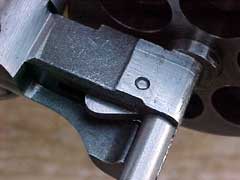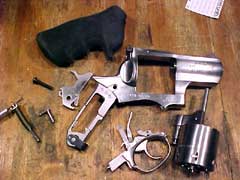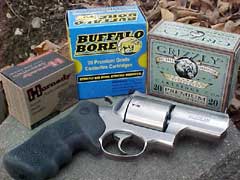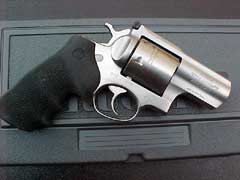|
About six months ago, I reviewed the .454
Casull version of the Super Redhawk Alaskan, so here I
will not plow the same ground with details of the weapon, but
rather attempt to display the potential power of the .480 Ruger
when fired from this short-barreled sixgun. One feature of these
Alaskans that should be noted, is that they do carry a full six
rounds in the cylinder instead of five. One cartridge may not
make any difference, but then again it just might.
The Alaskans are meant not as primary hunting
revolvers, even though they can serve in that role where the
short barrel does not legally eliminate them from that use, but
rather they are excellent sixguns to carry where one might need
a handy but powerful response to a really big animal that is set
on ruining the whole day. In this role, the Alaskan is a sound
choice. It is not so bulky as to be a burden, but packs a heavy
punch when needed.
As can be seen in the earlier article, the .454
Casull still hits pretty hard from the short-barreled Alaskan.
Now that the .480 Ruger version is in production, my goal here
was to see how the velocity of the .480 ammo would hold up.
The .480 Ruger Alaskan weighs just a bit less
than does the .454, with my sample weighing in at 42.2 ounces.
The trigger pull measured a smooth nine pounds, seven and
one-half ounces double action, and a crisp five and one-half
pounds single action. The barrel measured 2.588 inches in
length, and the barrel/cylinder gap an even .002 inch. Is
a very well fitted and finished revolver.
I again used the same excellent Simply Rugged
pancake holster that I featured in the .454 article. It is a
very good and versatile holster for the Alaskan, with the
ability to serve as a strong side or cross draw holster.
It offers excellent protection to the sixgun, while allowing
quick and easy access.
The recoil of the .480 Alaskan was about on par
with the .454 version. The .480 recoil did not seem as quick as
the .454, but with similar loads, little difference could be
detected. The padding on the Ruger grip at the web between the
thumb and trigger finger is superb. While the gun does jump a
bit upon firing, there is no pain involved. I tested a variety
of loads over the PACT chronograph. Velocity loss from
the short barrel compared to the velocity from longer tubes was
in the neighborhood of from one hundred and fifty to three
hundred feet per second. The tradeoff is a much handier weapon
for everyday packing in remote country or while fishing. The
average temperature was in the high forties for all chronograph
testing, at an elevation of about 600 feet above sea level. All
velocities are listed in feet-per-second. The loads tested and
results are as follows:
| Ammunition |
Velocity |
| Buffalo Bore 410 grain WFN |
1060 |
| Hornady 325 XTP |
1099 |
| Hornady 400 XTP |
1028 |
| Grizzly Cartridge 340 Belt Mountain Punch |
959.1 |
| Grizzly Cartridge 350 Hawk |
1016 |
| Grizzly Cartridge 375 LFNGC |
1034 |
| Grizzly Cartridge 400 Hawk |
957.9 |
| Grizzly Cartridge 425 WFNGC |
888.4 |
| Handload 390 Cast Performance LFNGC |
872.1 |
These loads are pretty impressive from such a
short-barreled belt gun. I would be hard-pressed to choose
between the .480 Ruger and .454 Casull versions of the Alaskan
for my own use. The .454 is more versatile, but the .480 throws
a bigger bullet. Either should serve its purpose very well.
Check out the full line of Ruger products
here.
For the location of a Ruger dealer near you, go
to: www.lipseys.com,
and click on the DEALER LOCATOR icon.
To order the beautiful and sturdy Simply Rugged
holster, go to: www.simplyrugged.com.
For more info on the factory ammo tested, click
on their websites: www.buffalobore.com,
www.grizzlycartridge.com,
and www.hornady.com.
Jeff Quinn
|
To locate a dealer where you can
buy this gun, Click on the DEALER FINDER icon at: |
|

|
  
Got something to say about this article? Want to agree (or
disagree) with it? Click the following link to go to the GUNBlast Feedback Page.
|
|
Click pictures for a larger version.

Ruger's Super Redhawk Alaskan in .480 Ruger.

Author fires the new .480 Ruger Super Redhawk Alaskan.


Sights consist of a fixed ramp front sight with Ruger's
familiar white-outline fully-adjustable rear sight.


Hammer is deeply checkered for positive function (top),
while the trigger is narrow and smoothly polished (bottom).




Ruger's Super Redhawks feature a very strong locking
system that locks the cylinder to the frame at both front and
rear for added strength and reliability.

Top strap and forcing cone area is beefy, plenty strong
for a steady diet of powerful loads.


The Super Redhawk Alaskan's excellent grips feature a
cushioned pad in the thumb web area, greatly diminishing
perceived recoil.

The Alaskan, like other Ruger DA revolvers, is a rugged
and reliable design that easily strips to its component parts.


The Super Redhawk Alaskan (top) packs a powerful punch,
but is not much larger than popular snubnose revolvers such as
Charter Arms' Bulldog (bottom).



Simply Rugged's holster for the Alaskan is versatile,
practical, well-crafted, and reasonably priced.


Ammo tested in the .480 Alaskan included (left to
right): Buffalo Bore 410-grain WFN, Hornady 325-grain XTP,
Hornady 400-grain XTP, Grizzly Cartridge 340-grain Punch,
Grizzly Cartridge 350-grain Hawk, Grizzly Cartridge 375-grain
LFNGC, Grizzly Cartridge 400-grain Hawk, Grizzly Cartridge
425-grain WFNGC, and Jeff's handload using the Cast
Performance 390-grain LFNGC bullet.

|
![]()